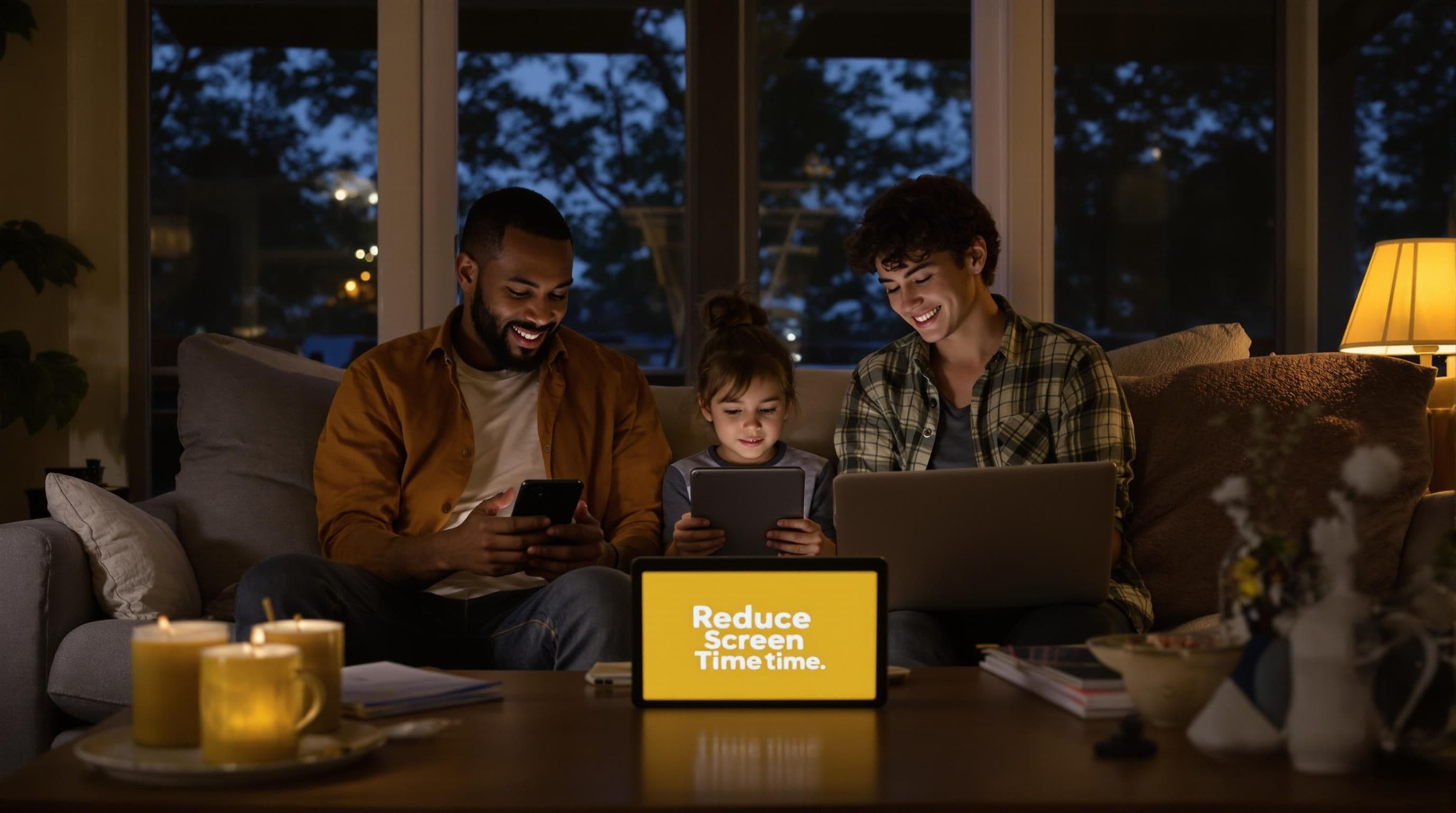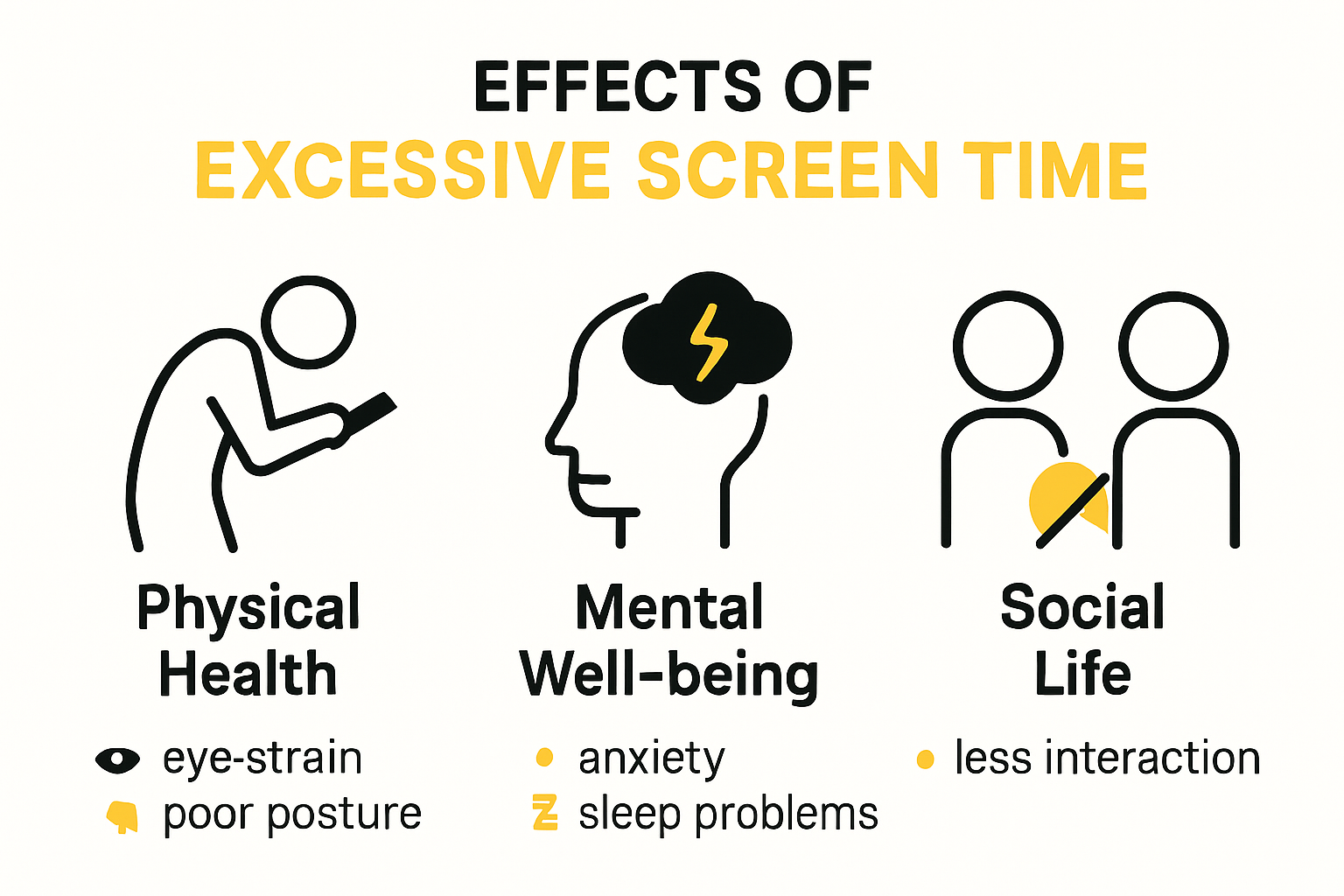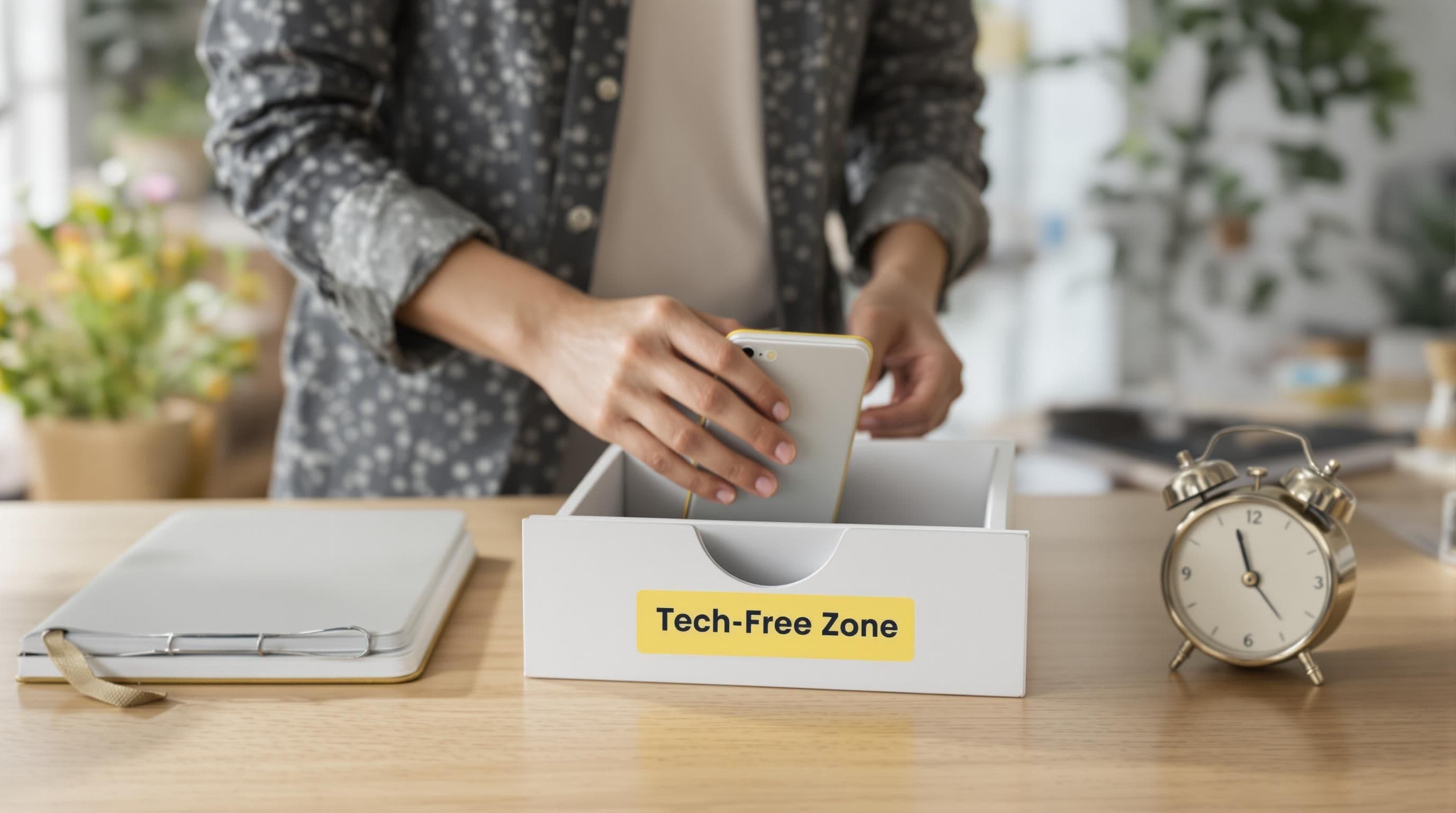
Everyone is glued to their screens these days. People spend over seven hours a day on digital devices on average, and it just keeps climbing. You might think all these gadgets make life easier and help us connect more. Surprisingly, spending too much time scrolling can actually harm your sleep, mental health, and even your relationships.
Table of Contents
- Understanding The Impact Of Excessive Screen Time
- Smart Habits For Reducing Daily Device Use
- Tech Solutions And Tools To Limit Screen Exposure
- Adapting Screen Time Goals For Different Lifestyles
Quick Summary
| Takeaway | Explanation |
|---|---|
| Establish digital boundaries | Create device-free zones and dedicated times to reduce impulsive screen usage. |
| Leverage screen time management tools | Use built-in device features and third-party apps for tracking and limiting screen exposure effectively. |
| Engage in alternative activities | Replace screen time with hobbies and social interactions to foster personal growth and wellbeing. |
| Tailor strategies to individual lifestyles | Customize screen time management approaches according to specific professional, family, and personal needs. |
| Track and adjust your screen time strategies | Regularly assess the effectiveness of your strategies and be flexible in making necessary adjustments. |
Understanding the Impact of Excessive Screen Time
Screen time has become an increasingly complex aspect of modern life, transforming how we work, communicate, and entertain ourselves. While digital technologies offer unprecedented connectivity, excessive screen exposure carries significant physical, mental, and social implications that demand our careful attention.

Physical Health Consequences of Prolonged Screen Use
The human body experiences multiple negative effects from extended digital device interaction. Harvard Health Publishing reports that prolonged screen time can trigger serious physiological disruptions. Eye strain represents one of the most immediate challenges, with symptoms including persistent headaches, blurred vision, and increased eye fatigue. The blue light emitted by digital screens directly impacts our natural sleep cycles, suppressing melatonin production and potentially leading to chronic sleep disorders.
Musculoskeletal problems emerge as another critical concern. Repetitive postures associated with device usage often result in what medical professionals term “tech neck” - a condition characterized by chronic neck and shoulder pain caused by constant forward head positioning. Sedentary behaviors linked to excessive screen time contribute to increased risks of obesity, cardiovascular issues, and reduced overall physical fitness.
Psychological and Cognitive Impacts
Beyond physical manifestations, excessive screen time profoundly influences mental well-being. American Psychological Association research suggests that constant digital engagement can significantly heighten anxiety, depression, and social isolation. The continuous stream of information and social media interactions creates neurological stress, overwhelming our cognitive processing capabilities.
Particularly concerning is the impact on attention spans and cognitive function. Constant digital stimulation fragments our concentration, making sustained focus increasingly challenging. Young professionals and students find themselves struggling to maintain deep, uninterrupted thinking patterns. The instant gratification culture promoted by digital platforms rewires neural pathways, potentially reducing our capacity for complex problem-solving and critical thinking.
Social and Interpersonal Dynamics
Perhaps most subtly destructive are the social consequences of excessive screen time. Digital interactions increasingly replace genuine human connections, eroding the nuanced communication skills developed through face-to-face interactions. Nonverbal cues, emotional intelligence, and the depth of interpersonal relationships suffer as screens mediate more of our social experiences.
Young professionals and tech-savvy individuals must recognize these multifaceted challenges. Understanding the comprehensive impact of screen time is not about complete digital abstinence but about developing conscious, balanced technological engagement. Strategic reduction and mindful usage can help mitigate these potential negative consequences, enabling us to harness digital technologies's benefits while protecting our holistic well-being.
Smart Habits for Reducing Daily Device Use
Reducing daily device use requires strategic planning and intentional behavioral modifications. By implementing targeted approaches, individuals can regain control over their digital consumption and create healthier technology interactions.
Creating Structured Digital Boundaries
American Academy of Pediatrics recommends establishing clear digital boundaries as a fundamental strategy for managing screen time. This involves creating dedicated device-free zones and time periods within daily routines. For tech professionals and early adopters, consider implementing specific protocols like designating work areas as technology-restricted spaces during non-working hours.

Designing physical environments that discourage constant device engagement can significantly reduce unconscious digital interactions. Place charging stations away from primary living and sleeping areas. Use physical barriers like drawer organizers or locked cabinets to create intentional friction between you and your devices. These subtle environmental modifications can dramatically decrease impulsive screen checking.
Technology-Assisted Screen Time Management
National Institute of Mental Health suggests leveraging technological tools to monitor and limit personal device usage. Many smartphones now include built-in screen time tracking features that provide detailed insights into digital consumption patterns. These tools offer comprehensive breakdowns of application usage, allowing users to identify and address problematic digital behaviors.
Utilize app-blocking software and built-in digital wellness features that allow scheduled device restrictions. Set automatic do-not-disturb modes during critical focus periods like work hours, personal time, or sleep cycles. Create custom profiles that limit notifications and application access during specific timeframes, enabling more intentional and controlled digital interactions.
Developing Alternative Engagement Strategies
Successful screen time reduction isn’t about complete digital abstinence but about creating meaningful alternative activities. Replace digital consumption with purposeful offline experiences that stimulate personal growth and genuine human connection. Develop hobbies that require physical interaction, such as gardening, cooking, exercise, or hands-on creative projects.
Encourage social interactions that do not revolve around digital platforms. Organize regular in-person meetups, participate in community events, or engage in group activities that foster genuine human connections. For professionals who spend significant time in digital environments, these alternative engagement strategies become crucial for maintaining mental wellness and preventing digital burnout.
By implementing these strategic approaches, individuals can transform their relationship with technology. The goal is not complete elimination but creating a balanced, intentional approach to digital consumption that supports personal and professional well-being.
Tech Solutions and Tools to Limit Screen Exposure
Technology offers innovative strategies for managing and reducing screen time, providing users with sophisticated tools to monitor, control, and optimize digital interactions. Understanding and implementing these solutions can transform our relationship with digital devices.
Below is a table comparing three major types of tech solutions for managing and reducing screen time, summarising their core features and ideal users:
| Solution Type | Key Features | Ideal Users |
|---|---|---|
| Native Device Management Tools | Built-in tracking & limitation, app usage breakdown, scheduling downtime, custom restrictions | Individuals & families |
| Advanced Monitoring & Control Apps | App/website blocking, productivity analytics, pomodoro integration, behaviour motivation | Professionals, students |
| Parental/Professional Control Ecosystems | Multi-device sync, granular permissions, real-time monitoring, team/family management | Families, workplaces |
Native Device Management Tools
National Heart, Lung, and Blood Institute highlights the importance of built-in device management features. Modern smartphones and computers now include comprehensive screen time tracking and limitation capabilities. These native tools provide detailed analytics about digital consumption, breaking down usage by application, time of day, and device category.
Apple and Android devices offer robust digital wellness features. iOS Screen Time and Android’s Digital Wellbeing tools allow users to set precise app usage limits, schedule downtime, and receive detailed reports about their digital habits. These integrated solutions enable users to set custom restrictions, blocking specific applications after predetermined time thresholds or during designated focus periods.
Advanced Monitoring and Control Applications
OECD’s Policy Research emphasizes the critical role of specialized applications in managing digital exposure. Third-party applications extend beyond basic device controls, offering more nuanced and customizable screen management strategies. Applications like RescueTime, Forest, and Freedom provide advanced tracking, productivity enhancement, and strategic digital intervention mechanisms.
These sophisticated tools offer features such as website blocking, pomodoro timer integration, detailed productivity analytics, and gamified motivation strategies. Some applications use behavioral psychology principles to encourage reduced screen time, offering rewards or visual representations of digital discipline achievements.
Parental and Professional Control Ecosystems
Academic Research on Parental Control Technologies reveals complex ecosystems of digital management tools designed for families and professional environments. Modern parental control applications go beyond simple restriction mechanisms, providing comprehensive digital safety and usage management platforms.
Advanced solutions offer multi-device synchronization, granular permission settings, and real-time monitoring capabilities. For professional environments, these tools can help manage team productivity, limit potentially distracting applications, and create structured digital work environments. Some enterprise solutions integrate screen time management with broader digital wellness and cybersecurity strategies.
Implementing these technological solutions requires a strategic and personalized approach. The goal is not complete digital elimination but creating intentional, balanced technological interactions that support personal and professional growth. By leveraging these innovative tools, individuals can develop healthier digital habits, improve focus, and reclaim control over their technological experiences.
Adapting Screen Time Goals for Different Lifestyles
Screen time management is not a one-size-fits-all approach. Different professional roles, personal circumstances, and lifestyle demands require tailored strategies that recognize individual needs while promoting healthy digital interactions.
The following table summarises strategies for adapting screen time goals based on lifestyle and user context:
| Lifestyle/User Context | Main Challenge | Recommended Strategy |
|---|---|---|
| Tech Professionals | High daily screen use for work | Focus blocks, schedule breaks, time-blocking |
| Families with Children | Balancing generational tech needs | Collaborative agreements, shared guidelines |
| Health-Conscious Seniors | Comfort/skill level with technology | Simple limits, offline activities, support |
| Small Business Owners/DIY | Irregular schedules, digital reliance | Flexible plans, alternative engagement |
| Students | Distraction, fragmented attention | App blocking, focus sessions, group activities |
Professional Adaptation Strategies
American Journal of Preventive Medicine research highlights the importance of personalized screen time interventions across various professional contexts. Tech professionals and early adopters face unique challenges, requiring nuanced approaches that balance digital productivity with personal well-being.
For individuals in technology-driven roles, screen time management becomes about strategic optimization rather than complete reduction. Implement techniques like dedicated focus blocks, where specific hours are allocated for deep work with minimal digital interruptions. Use productivity frameworks such as time-blocking to create structured digital engagement periods, allowing for concentrated work while preventing continuous screen exposure.
Family and Personal Life Considerations
National Heart, Lung, and Blood Institute emphasizes the critical role of creating comprehensive family strategies for screen time management. Health-conscious seniors and families require approaches that consider multiple generational needs and technological comfort levels.
Develop collaborative screen time agreements that involve all family members. Create shared guidelines that establish clear expectations about device usage during meals, family time, and personal interactions. For households with diverse age groups, consider implementing graduated screen time limits that adapt to individual developmental stages and professional requirements.
Lifestyle-Specific Intervention Approaches
American Heart Association recommends developing comprehensive lifestyle strategies that replace screen time with meaningful alternative activities. This approach is particularly crucial for DIY enthusiasts and small business owners who require flexible yet structured digital engagement.
Design personalized intervention plans that consider individual lifestyle constraints. For professionals with irregular work schedules, implement flexible screen time management techniques that allow for adaptive digital usage. Create alternative engagement strategies like physical exercise routines, hobby development, and social interaction protocols that naturally reduce digital dependency.
Successful screen time adaptation requires continuous assessment and willingness to modify strategies. Regularly evaluate the effectiveness of implemented approaches, remaining open to adjusting techniques based on changing personal and professional demands. The ultimate goal is developing a balanced, intentional relationship with digital technologies that supports overall well-being and productivity across different lifestyle contexts.
Frequently Asked Questions
How can I effectively reduce my screen time?
To effectively reduce screen time, establish digital boundaries by creating device-free zones and specific times to engage in non-digital activities. Leverage screen time management tools available on your devices to monitor usage and implement scheduled breaks during your day.
What are the physical effects of excessive screen time?
Excessive screen time can lead to various physical health issues, including eye strain, headaches, and musculoskeletal problems such as ‘tech neck.’ It can also disrupt sleep by affecting melatonin production due to blue light exposure from screens.
What strategies can I use to engage in alternative activities?
Replace screen time with engaging offline activities such as gardening, cooking, or joining local community events. Focus on hobbies that allow for physical interaction and foster social connections, like in-person meetups, to help reduce reliance on digital devices.
How can parents manage their children’s screen time effectively?
Parents can manage children’s screen time by setting collaborative agreements within the family. Establish clear guidelines for device usage, such as limiting screen time during meals and family time, and using parental control applications to monitor and set restrictions on digital exposure.
Upgrade Your Digital Wellness with Smarter Choices
Are you looking to cut down on screen time and regain control of your tech habits? This article highlights how overwhelming device use can damage your health, focus, and even your relationships. But reducing screen time should not mean cutting yourself off from technology entirely. The real solution is to choose better tools that help you find balance and enhance your everyday life.
South Africans who want to invest in tech products that make their lives easier without adding to digital overload can turn to PMC Jewellery’s best sellers. Discover mobile accessories, smart wearables, health devices, and more designed to help you manage your screen time. Get the best deals and quality in one smart marketplace, where premium performance does not come with a premium price tag. Ready for a healthier digital lifestyle? Visit https://pmcjewellery.co.za/collections/best-selling right now and see which top-rated products can support your 2025 screen time goals.
